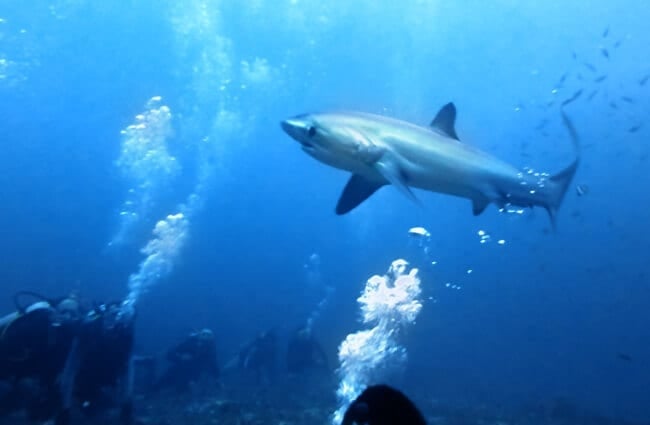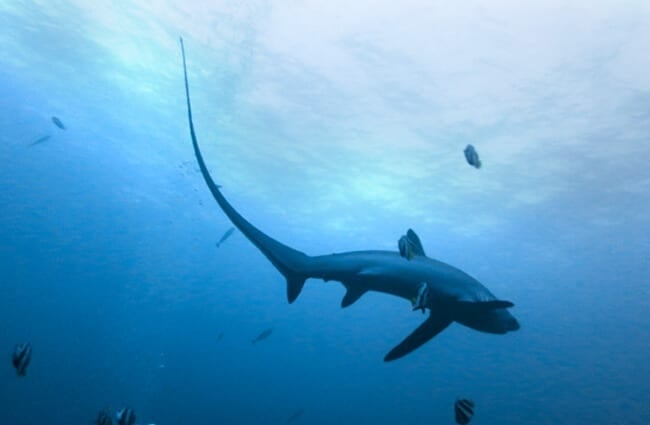The Remarkable Thresher Shark: A Deep Dive into the “Whip-Tailed” Predator
The ocean holds many wonders, but few are as captivating and unique as the thresher shark. Known for its extraordinarily long tail, which can equal the shark’s body length, this creature is a master of its marine environment. This guide will explore every facet of the thresher shark’s life, from its evolutionary history and hunting techniques to its role in the ecosystem and the threats it faces. Prepare to be amazed by this remarkable predator.

Understanding Thresher Sharks: Basic Biology and Identification
Physical Characteristics
Thresher sharks belong to the family Alopiidae, and there are three recognized species: the common thresher (Alopias vulpinus), the bigeye thresher (Alopias superciliosus), and the pelagic thresher (Alopias pelagicus). All share the defining characteristic of an elongated caudal fin—the tail—which comprises a substantial portion of their total length. The common thresher can reach lengths of over 18 feet, with the tail accounting for nearly half of that. Bigeye threshers are distinguished by their larger eyes, and pelagic threshers are generally smaller and more slender.
Their bodies are streamlined, built for speed and agility in open water. They have relatively small mouths, lack the fearsome dentition of some other shark species, and possess slender teeth adapted for grasping rather than tearing.
Habitat and Distribution
Thresher sharks are found in tropical and temperate waters worldwide, inhabiting both coastal and oceanic environments. They prefer water temperatures between 50 and 75 degrees Fahrenheit. They are highly migratory, traveling long distances in search of food and suitable breeding grounds. Common threshers are known to inhabit continental shelf waters, while bigeye and pelagic threshers tend to favor deeper, offshore waters.

The Hunting Strategy: Utilizing the Extraordinary Tail
A Unique Predatory Technique
The thresher shark’s elongated tail is not merely a physical curiosity; it is a sophisticated hunting tool. The shark uses its tail to deliver powerful, whipping blows that stun or incapacitate schooling fish and squid. This technique is especially effective against dense schools, allowing the shark to capture and consume its stunned victims with ease.
Dietary Habits
The diet of thresher sharks varies depending on the species and location. Common threshers primarily feed on schooling fish such as herring, sardines, and mackerel. They also consume squid and crustaceans. Bigeye threshers tend to feed on deep‑water fish and squid, while pelagic threshers focus on smaller pelagic fish.
Life History: Reproduction and Growth
Reproductive Biology
Thresher sharks are ovoviviparous, meaning the embryos develop within eggs retained inside the mother’s body. The gestation period is thought to be exceptionally long, exceeding a year and potentially extending beyond 18 months. Litters are small, typically ranging from two to ten pups. Pups are born relatively large, measuring around 5 to 6 feet in length.
Growth and Lifespan
Thresher sharks grow slowly and mature late in life. They are estimated to reach sexual maturity around 8 to 15 years of age. Their lifespan is still not fully understood, but estimates suggest they can live for over 30 years, possibly even longer.

Ecological Role and Interactions
Position in the Food Web
As top predators, thresher sharks play a crucial role in maintaining the balance of marine ecosystems. By regulating populations of schooling fish, they prevent those fish from over‑consuming plankton, thereby supporting the overall health of the food web. They may occasionally fall prey to larger sharks, such as great white sharks, or to orcas.
Interactions with Other Species
Thresher sharks are generally not considered dangerous to humans. Encounters are rare, and attacks are exceedingly uncommon. They primarily interact with humans through fisheries, where they can be caught as bycatch or targeted for their fins, meat, and oil. They are also popular with divers, providing thrilling encounters for those lucky enough to spot them.
Thresher Sharks and Humans: Conservation Status and Threats
Conservation Concerns
All three species of thresher shark are listed as Vulnerable or Endangered by the International Union for Conservation of Nature (IUCN). Their populations are declining due to overfishing, bycatch, and habitat degradation. The demand for shark fins, meat, and oil continues to drive unsustainable fishing practices.
Conservation Efforts
Conservation efforts include implementing fishing regulations, reducing bycatch, establishing marine protected areas, and raising awareness about the importance of shark conservation. International cooperation is crucial to protect these highly migratory species.

Deeper Dive: Evolutionary History and Unique Adaptations
Evolutionary Origins
The evolutionary history of thresher sharks dates back to the Eocene epoch, approximately 56 to 34 million years ago. Fossil records suggest that early thresher sharks were similar to modern species, possessing the characteristic elongated tail. The evolution of the tail is believed to be linked to the development of a specialized hunting strategy for targeting schooling fish.
Physiological Adaptations
Beyond the obvious tail adaptation, thresher sharks possess several physiological features that contribute to their success as predators. These include a countercurrent exchange system in their muscles, which helps maintain a higher body temperature and allows for sustained swimming, and a highly developed sensory system that enables them to detect prey in low‑light conditions.
Encountering a Thresher Shark: A Guide for Divers and Observers
If you are fortunate enough to encounter a thresher shark while diving or boating, maintain a respectful distance and avoid any actions that could disturb the animal. Do not attempt to approach or touch the shark. Observe its behavior from a safe distance and allow it to move freely. Report any sightings to local marine research organizations to contribute to ongoing monitoring and conservation efforts.
The thresher shark is a testament to the incredible diversity and adaptability of life in the ocean. By understanding and appreciating this remarkable creature, we can contribute to its conservation and ensure that future generations can continue to marvel at its unique beauty and ecological importance.

![Red Angus Closeup of a beautiful Red Angus cowPhoto by: U.S. Department of Agriculture [pubic domain]https://creativecommons.org/licenses/by/2.0/](https://animals.net/wp-content/uploads/2020/03/Red-Angus-4-238x178.jpg)




![Red Angus Closeup of a beautiful Red Angus cowPhoto by: U.S. Department of Agriculture [pubic domain]https://creativecommons.org/licenses/by/2.0/](https://animals.net/wp-content/uploads/2020/03/Red-Angus-4-100x75.jpg)

